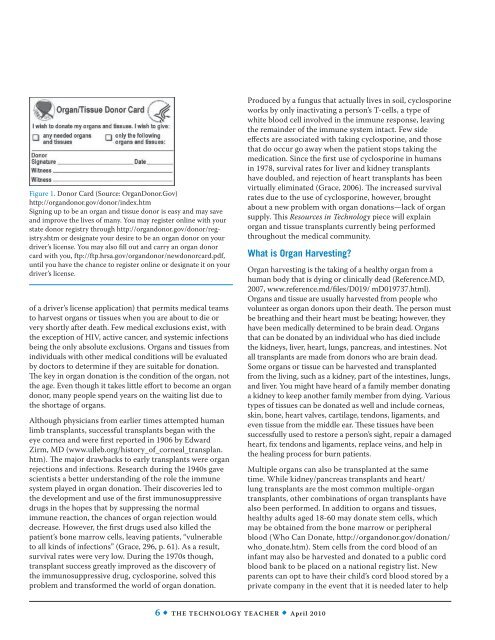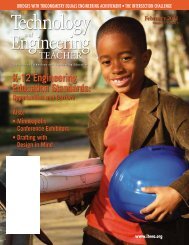Medical Technology: organ harvesting and Transplants
Medical Technology: organ harvesting and Transplants
Medical Technology: organ harvesting and Transplants
You also want an ePaper? Increase the reach of your titles
YUMPU automatically turns print PDFs into web optimized ePapers that Google loves.
Figure 1. Donor Card (Source: OrganDonor.Gov)<br />
http://<strong>organ</strong>donor.gov/donor/index.htm<br />
Signing up to be an <strong>organ</strong> <strong>and</strong> tissue donor is easy <strong>and</strong> may save<br />
<strong>and</strong> improve the lives of many. You may register online with your<br />
state donor registry through http://<strong>organ</strong>donor.gov/donor/registry.shtm<br />
or designate your desire to be an <strong>organ</strong> donor on your<br />
driver’s license. You may also fill out <strong>and</strong> carry an <strong>organ</strong> donor<br />
card with you, ftp://ftp.hrsa.gov/<strong>organ</strong>donor/newdonorcard.pdf,<br />
until you have the chance to register online or designate it on your<br />
driver’s license.<br />
of a driver’s license application) that permits medical teams<br />
to harvest <strong>organ</strong>s or tissues when you are about to die or<br />
very shortly after death. Few medical exclusions exist, with<br />
the exception of HIV, active cancer, <strong>and</strong> systemic infections<br />
being the only absolute exclusions. Organs <strong>and</strong> tissues from<br />
individuals with other medical conditions will be evaluated<br />
by doctors to determine if they are suitable for donation.<br />
The key in <strong>organ</strong> donation is the condition of the <strong>organ</strong>, not<br />
the age. Even though it takes little effort to become an <strong>organ</strong><br />
donor, many people spend years on the waiting list due to<br />
the shortage of <strong>organ</strong>s.<br />
Although physicians from earlier times attempted human<br />
limb transplants, successful transplants began with the<br />
eye cornea <strong>and</strong> were first reported in 1906 by Edward<br />
Zirm, MD (www.ulleb.org/history_of_corneal_transplan.<br />
htm). The major drawbacks to early transplants were <strong>organ</strong><br />
rejections <strong>and</strong> infections. Research during the 1940s gave<br />
scientists a better underst<strong>and</strong>ing of the role the immune<br />
system played in <strong>organ</strong> donation. Their discoveries led to<br />
the development <strong>and</strong> use of the first immunosuppressive<br />
drugs in the hopes that by suppressing the normal<br />
immune reaction, the chances of <strong>organ</strong> rejection would<br />
decrease. However, the first drugs used also killed the<br />
patient’s bone marrow cells, leaving patients, “vulnerable<br />
to all kinds of infections” (Grace, 296, p. 61). As a result,<br />
survival rates were very low. During the 1970s though,<br />
transplant success greatly improved as the discovery of<br />
the immunosuppressive drug, cyclosporine, solved this<br />
problem <strong>and</strong> transformed the world of <strong>organ</strong> donation.<br />
Produced by a fungus that actually lives in soil, cyclosporine<br />
works by only inactivating a person’s T-cells, a type of<br />
white blood cell involved in the immune response, leaving<br />
the remainder of the immune system intact. Few side<br />
effects are associated with taking cyclosporine, <strong>and</strong> those<br />
that do occur go away when the patient stops taking the<br />
medication. Since the first use of cyclosporine in humans<br />
in 1978, survival rates for liver <strong>and</strong> kidney transplants<br />
have doubled, <strong>and</strong> rejection of heart transplants has been<br />
virtually eliminated (Grace, 2006). The increased survival<br />
rates due to the use of cyclosporine, however, brought<br />
about a new problem with <strong>organ</strong> donations—lack of <strong>organ</strong><br />
supply. This Resources in <strong>Technology</strong> piece will explain<br />
<strong>organ</strong> <strong>and</strong> tissue transplants currently being performed<br />
throughout the medical community.<br />
What is Organ Harvesting?<br />
Organ <strong>harvesting</strong> is the taking of a healthy <strong>organ</strong> from a<br />
human body that is dying or clinically dead (Reference.MD,<br />
2007, www.reference.md/files/D019/ mD019737.html).<br />
Organs <strong>and</strong> tissue are usually harvested from people who<br />
volunteer as <strong>organ</strong> donors upon their death. The person must<br />
be breathing <strong>and</strong> their heart must be beating; however, they<br />
have been medically determined to be brain dead. Organs<br />
that can be donated by an individual who has died include<br />
the kidneys, liver, heart, lungs, pancreas, <strong>and</strong> intestines. Not<br />
all transplants are made from donors who are brain dead.<br />
Some <strong>organ</strong>s or tissue can be harvested <strong>and</strong> transplanted<br />
from the living, such as a kidney, part of the intestines, lungs,<br />
<strong>and</strong> liver. You might have heard of a family member donating<br />
a kidney to keep another family member from dying. Various<br />
types of tissues can be donated as well <strong>and</strong> include corneas,<br />
skin, bone, heart valves, cartilage, tendons, ligaments, <strong>and</strong><br />
even tissue from the middle ear. These tissues have been<br />
successfully used to restore a person’s sight, repair a damaged<br />
heart, fix tendons <strong>and</strong> ligaments, replace veins, <strong>and</strong> help in<br />
the healing process for burn patients.<br />
Multiple <strong>organ</strong>s can also be transplanted at the same<br />
time. While kidney/pancreas transplants <strong>and</strong> heart/<br />
lung transplants are the most common multiple-<strong>organ</strong><br />
transplants, other combinations of <strong>organ</strong> transplants have<br />
also been performed. In addition to <strong>organ</strong>s <strong>and</strong> tissues,<br />
healthy adults aged 18-60 may donate stem cells, which<br />
may be obtained from the bone marrow or peripheral<br />
blood (Who Can Donate, http://<strong>organ</strong>donor.gov/donation/<br />
who_donate.htm). Stem cells from the cord blood of an<br />
infant may also be harvested <strong>and</strong> donated to a public cord<br />
blood bank to be placed on a national registry list. New<br />
parents can opt to have their child’s cord blood stored by a<br />
private company in the event that it is needed later to help<br />
6 • The <strong>Technology</strong> Teacher • April 2010

















